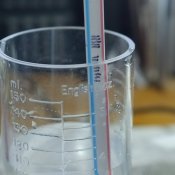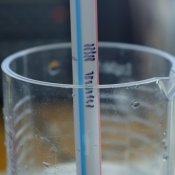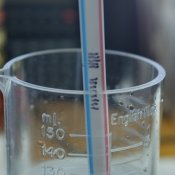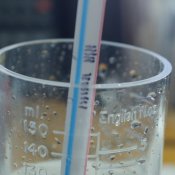NedL
Subscriber
Hello chemists in our midst,
Is there an easy, crude way to estimate the concentration of salt, say to within a percent or so? I have about 500ml of water with an unknown quantity of ( mostly sea, but maybe some bittern ) salt. Searching around a bit but end up at aquarium websites that say you need a fancy conductivity meter.... I have an ohmmeter, thermometer, scale, graduated cylinder... I'd be perfectly happy if I could even distinguish between say 1% and 5% solution. The two ideas I've thought of so are are:
1) weigh a small cup, add a small measured sample, boil in microwave until no liquid is left, then weigh again.
2) stick my ohmmeter probes in, then do the same with a cup of water adding salt until I get the same reading...
Oh, if it matters, I've already added 1.5g citric acid.
Or, alternatively, if I make a salt print, what are the signs of too high and too low a concentration? I've read that if it is too high the print will be weak and pinker, but anything more specific?? The last time I used sea salt for a salt print, I got staining and fog, but I didn't play with the concentrations much....
Is there an easy, crude way to estimate the concentration of salt, say to within a percent or so? I have about 500ml of water with an unknown quantity of ( mostly sea, but maybe some bittern ) salt. Searching around a bit but end up at aquarium websites that say you need a fancy conductivity meter.... I have an ohmmeter, thermometer, scale, graduated cylinder... I'd be perfectly happy if I could even distinguish between say 1% and 5% solution. The two ideas I've thought of so are are:
1) weigh a small cup, add a small measured sample, boil in microwave until no liquid is left, then weigh again.
2) stick my ohmmeter probes in, then do the same with a cup of water adding salt until I get the same reading...
Oh, if it matters, I've already added 1.5g citric acid.
Or, alternatively, if I make a salt print, what are the signs of too high and too low a concentration? I've read that if it is too high the print will be weak and pinker, but anything more specific?? The last time I used sea salt for a salt print, I got staining and fog, but I didn't play with the concentrations much....






